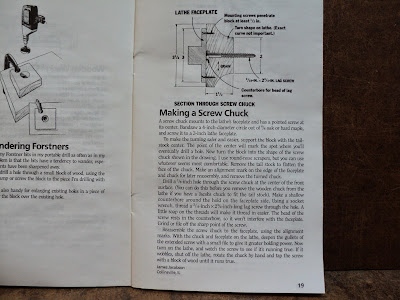My son acquired an old specimen of the subject mitre saw recently for very little money, and it looks like he got lucky -- the saw did a useful job for him on some renovation work at his home. Here's a view of the machine.
Since he has no immediate further need of the saw, we thought it would be a good idea to give the machine a teardown, inspection and some TLC, so there'll be no surprises come the next time the saw is needed.
This post will serve to document my work on the saw. The material that shows up here may not always be in the most coherent, linear order; I'm not claiming to create a proper service manual.
Motor Brushes
Brush access is good. Remove three M4x16mm truss head threading screws, and you can pull off the motor's end-cover.[1] That gets you to here.
When removing brushes that will be re-installed, it's a good idea to unambiguously mark the holders and brushes, so you can get them back in place exactly as they were. Old brushes will have mated themselves to their original installation, and will last longest if returned to that installation. Just make some dot marks with an engraver to tell you what goes back where.
The brushes from this motor look fine -- evenly worn, and with plenty of length left to go.
- - -
Blade Removal
Remove the blade guard to gain access to the blade's fastening screw.
There's a single M6 hex socket head cap screw that secures the blade guard adjustment link.
Remove that screw with a 5mm hex key, and it's pretty obvious from there on how the blade guard comes off.
A 13mm A/F hex washerhead screw secures the blade.
The screw has a left hand thread. To remove it --
- Lock the saw's arm in its storage position. (There's a locking plunger at the upper right side of the pivot column.)
- Jam the blade with a scrap of hardwood.[2]
- Turn the screw clockwise.
Like so.
And if it weren't for the seven chipped teeth, this saw would have a very nice 40-tooth Hitachi blade on it.
- - -
Motor/Gearbox Removal -- FRIDAY, JANUARY 23, 2015
Three M5x75mm screws secure the motor/gearbox assembly to the saw frame.
I'll clean everything up with compressed air, then decide whether I should open up the gearbox to re-grease it.
- - -
I decided to leave the gearbox unopened. Given the condition of the brushes, there can't be a lot of run time on this unit, so there's really no compelling reason for me to relubricate the gearbox at this time.
- - -
Blade Guard Adjustment -- SATURDAY, JANUARY 24, 2015
When we got the machine, its blade guard was inoperative -- the guard was jammed in its fully raised position. It turned out that the guard had been deliberately mis-assembled to disable it, and keep it raised at all times. Now that I have the guard working, I think I see why the original owner disabled it.
The guard's default geometry is such that guard operation adds a little to the force needed to start lowering the saw to make a cut. There's an adjustment that can be made to correct that. Here's a view of the guard's at-rest state as the factory no doubt sets it up.
Note that the guard is fully lowered/closed; the rear edge of the guard is stopped against a small, round bumper. Opening the guard from that position takes a perceptible bit of force, and a user might find that characteristic of the guard annoying.
The at-rest position of the guard can be adjusted so that the guard never fully closes, and that does away with the effort needed to start the guard opening. The attendant loss of guard protection is minimal.
To make the adjustment, loosen off the screw in the middle of the short link at the left with a 5mm hex key. Alter the guard's at-rest position so the guard is partly open when at rest, and retighten the screw. The guard's new at-rest position will look like this.
Note that the rear edge of the guard no longer contacts the bumper -- it comes to rest about an inch away from the bumper. By introducing that partially-open condition to the guard's at-rest state, the effort needed to start further opening the guard is made negligible.
- - -
Notes:
[1] All three screw well bottoms were broken out of the cover on this unit. The same thing probably happens to all of them. I glued the well bottoms back in place with CA adhesive. Here's a view of the inside of the cover after repair.
Update -- SATURDAY, JANUARY 24, 2015
That repair failed. I redid the repair by using long enough screws to secure the cover by its outer end surface, like so.
The hardware complement there is:
- 1x No. 8 x 1 1/4" flat head wood screw.
- 2x No. 8 x 2" flat head wood screw.
- 3x 3/16" fender washer.
- 1x No. 8 cup washer.
End of that problem.
[2] Alternatively, you can hold the blade from turning by means of a 5mm hex key inserted into the motor's shaft-end at the right side.
# # #
# # #




































